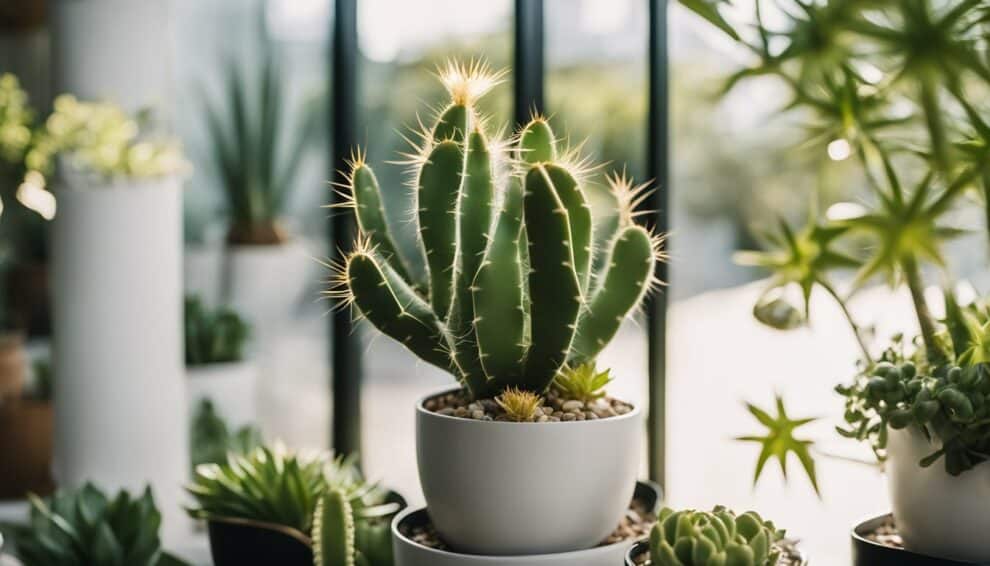The Fishbone Cactus, also known as Epiphyllum Anguliger, is a unique and visually stunning plant that has become increasingly popular among modern gardeners.
Its distinctive appearance, with long, flat, and serrated stems that resemble a fishbone, makes it a standout addition to any indoor garden.
However, despite its popularity, many gardeners are unsure of how to properly care for this unique plant.

One of the key factors in successfully caring for a Fishbone Cactus is understanding its natural habitat.
Native to the tropical rainforests of Central and South America, this plant is an epiphyte, meaning it grows on other plants and trees rather than in soil.
This makes it well-suited for growing in containers or hanging baskets with a well-draining soil mix.
In addition to proper soil, the Fishbone Cactus also requires bright, indirect light and moderate humidity to thrive.
With the right care, this unique plant can be a stunning addition to any indoor garden.
Getting to Know the Fishbone Cactus
The Fishbone Cactus, also known as Epiphyllum Anguliger, is a unique and trendy plant that has become increasingly popular among modern gardeners.
This cactus is native to Central and South America and is known for its distinctive appearance and easy care requirements.
The Fishbone Cactus gets its name from its long, flat, and segmented stems that resemble a fishbone.
These stems can grow up to 3 feet long and are a beautiful shade of green with white stripes that run down the length of the stem.
The plant produces beautiful white or pink flowers that bloom at night and last for only one day.
One of the great things about the Fishbone Cactus is that it’s easy to care for.
It’s a low-maintenance plant that doesn’t require much attention.
It can be grown indoors or outdoors, as long as it’s in a warm and humid environment.
The plant prefers bright, indirect light and should be watered once a week during the growing season and less frequently during the winter months.
In addition to its unique appearance and easy care requirements, the Fishbone Cactus has several other benefits.
It’s a great air purifier and can help remove toxins from the air.
It’s also a natural stress reliever and can help improve your mood and overall well-being.
Overall, the Fishbone Cactus is a great addition to any plant collection.
Its unique appearance, easy care requirements, and health benefits make it a popular choice for modern gardeners.
Essential Care Tips

Lighting Requirements
Fishbone cactus prefers bright, indirect light.
Direct sunlight can scorch the leaves, so it’s best to place the plant near a window with filtered sunlight.
If the plant is not receiving enough light, the leaves may turn yellow and drop.
Watering Practices
The epiphyllum anguliger is a succulent, which means it stores water in its leaves and stems.
Overwatering can lead to root rot, so it’s important to let the soil dry out completely between waterings.
In the winter, reduce watering frequency as the plant goes into a dormant period.
Soil and Repotting
The fishbone cactus prefers a well-draining soil mix. A combination of potting soil, perlite, and sand can provide good drainage.
Repotting should be done every 2-3 years or when the plant has outgrown its container. When repotting, be careful not to damage the roots.
Temperature and Humidity
Fishbone cactus prefers temperatures between 60-80°F (15-27°C). It can tolerate cooler temperatures in the winter, but avoid placing it near cold drafts.
The plant prefers moderate to high humidity levels, so misting the leaves or placing a humidifier nearby can be beneficial.
Overall, the fishbone cactus is a relatively low-maintenance plant that can add an interesting touch to any indoor garden.
By following these essential care tips, the modern gardener can keep their epiphyllum anguliger healthy and thriving.
Propagation Techniques

Stem Cuttings
One of the easiest ways to propagate Fishbone Cactus is through stem cuttings.
To do this, take a healthy stem cutting from the mother plant, making sure it is at least 4 inches long.
Allow the cutting to dry for a few days before planting it in a well-draining soil mix.
Keep the soil moist and warm, and in a few weeks, you should see new growth emerging from the cutting.
Seeds
Fishbone Cactus can also be propagated from seeds, although this method requires more patience and attention.
Collect the seeds from a mature plant and plant them in a well-draining soil mix.
Keep the soil consistently moist and warm, and in a few weeks, you should see the seeds start to germinate.
It may take several months for the seedlings to grow large enough to be transplanted into their own pots.
When propagating Fishbone Cactus, it’s important to remember that the new plants may not have the same unique characteristics as the parent plant.
However, with proper care and attention, they can still thrive and add beauty to any collection.
Troubleshooting Common Issues

Pest Infestations
Fishbone cactus plants are susceptible to common pests such as spider mites, mealybugs, and scale insects.
Signs of infestation include yellowing or wilting of leaves, sticky residue on the plant, and small insects on the plant.
To combat these pests, regularly inspect the plant and remove any visible pests by wiping them off with a damp cloth.
For severe infestations, use an insecticidal soap or neem oil spray.
Diseases
Fishbone cactus is generally a hardy plant, but it can be affected by fungal or bacterial diseases.
Signs of disease include brown spots on leaves, wilting, and stem rot. To prevent disease, ensure that the plant is not overwatered and has proper drainage.
If disease is detected, remove the affected parts of the plant and treat with a fungicide or bactericide.
Environmental Stress
Fishbone cactus can experience stress from environmental factors such as temperature fluctuations and improper lighting.
Signs of stress include yellowing or browning of leaves, stunted growth, and wilting.
To prevent stress, ensure that the plant is in a location with consistent temperature and lighting.
If stress is detected, adjust the plant’s environment accordingly and consider fertilizing with a balanced fertilizer to promote healthy growth.
Frequently Asked Questions

What type of lighting conditions are ideal for a Fishbone Cactus?
Fishbone cactus, also known as Epiphyllum Anguliger, thrives in bright, indirect light.
It is best to place the plant near a window that receives filtered sunlight or in a shaded area of your garden.
Direct sunlight can scorch the leaves of the plant, so it is important to avoid placing it in direct sunlight.
How often should I water my Fishbone Cactus?
Fishbone cactus prefers well-draining soil and requires infrequent watering. It is important to allow the soil to dry out between watering sessions.
Overwatering can lead to root rot and other fungal diseases.
As a general rule, it is recommended to water the plant once a week during the growing season and reduce watering during the dormant season.
Can you explain the propagation process for a Fishbone Cactus?
Fishbone cactus can be propagated through stem cuttings. To propagate, take a healthy stem cutting and allow it to callus for a few days.
Once the cutting has callused, plant it in well-draining soil and water it sparingly.
Keep the cutting in a warm, humid area until it has established roots and new growth.
What is the typical blooming season for the Fishbone Cactus?
Fishbone cactus typically blooms in the spring and summer months.
The flowers are fragrant and bloom at night, attracting pollinators such as moths and bats.
Does the Fishbone Cactus emit a fragrance when it flowers?
Yes, the Fishbone Cactus emits a sweet, citrusy fragrance when it blooms. The fragrance is strongest at night when the flowers are open.
Why does my Fishbone Cactus have aerial roots, and what should I do about them?
Aerial roots are common in epiphytic plants such as the Fishbone Cactus.
They are used to anchor the plant to trees and other surfaces in their natural habitat.
If the aerial roots are not causing any harm to the plant, it is best to leave them be.
However, if they are becoming a nuisance, they can be trimmed off with a sharp, clean pair of scissors.














